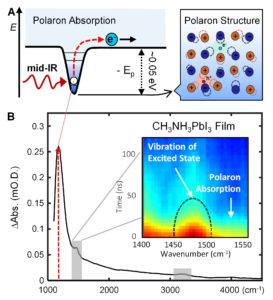Magnitude Instruments enables orders of magnitude reduction of noise allowing ultrabroadband, low intensity probe sources to be used in place of ultrafast or quantum cascade lasers in nanosecond mid-infrared TA spectroscopy.
Ultrabroadband Mid-IR TA Spectroscopy with High Frequency and Time Resolution
Table of Contents
ABSTRACT: Recent advances in noise suppression technology from Magnitude Instruments has fundamentally changed state of the art nanosecond mid-IR transient absorption (TA) spectroscopy measurements by enabling low intensity, ultrabroadband mid-IR probe sources to be used in place of expensive, high maintenance laser sources traditionally used in the field. Here we focus on one application of these advances where the ability to measure TA spectra continuously across the entire mid-IR spectral region with high frequency resolution enabled new opportunities to examine electronic transport states in halide perovskites and to reveal the structural dynamics that give rise to those states.
Contemporary applications of mid-IR transient absorption (TA) spectroscopy span diverse fields ranging from optoelectronic materials characterization to transport processes in complex fluids and proteins. One of the unique advantages of mid-IR TA spectroscopy is the ability to examine the dynamics and chemical reactivity of samples and to simultaneously probe the structural dynamics that underpin that reactivity.1 In many cases, this requires measurement of two very different types of spectral signatures. The first of these are broad transient absorption features in the mid-IR that are often related to electronic transport states or chemical intermediates. For example, charge transport states in halide perovskite photovoltaic materials known as large polarons exhibit broad absorptions that span the entire mid-IR spectral region (Figure 1).2 These absorptions result from photoionization of self-trapped carriers in large polarons back into extended transport states.

Figure 1. A Schematic diagram depicting the photoionization of large polarons to free-carrier continuum states probed by mid-IR TA spectroscopy with the corresponding structural distortions that underpin polaron formation. B TRIR spectrum spanning the mid-IR spectral region collected at 30 ns following pulsed excitation at 532 nm. The spectra reveal the distinct absorption of large polarons. The gray shaded box highlights the N-H bend and stretch regions of CH3NH3+ ions in the halide perovskite film. Inset 2D frequency-time surface plot highlighting the vibrational feature superimposed on the broad polaron absorption that reveals the lattice dynamics underpinning polaron formation (Ref. 2). Adapted with permission from J. Phys. Chem. C 2019, 123, 7061–7073. Copyright (2019) American Chemical Society.
The second type of transition consists of vibrational features that are often superimposed on the broad absorptions and that allow measurements of the structural dynamics of the system. In the case of the mid-IR TA spectra of the methylammonium halide perovskite CH3NH3PbI3 in Figure 1B, the N-H bend and stretch vibrational features are apparent in the transient spectra (gray shaded boxes). The vibrational dynamics that determine the linewidths of these transitions provide information about the structural dynamics of the perovskite lattice. The ability to simultaneously measure both the broad polaron absorption and the narrow vibrational features revealed how the structure and dynamics of the perovskite lattice influenced polaron formation.2 This in turn provided new insight as to why halide perovskites exhibit such remarkable charge transport and recombination properties that underpin their unprecedented high performance in photovoltaic devices.
Traditionally, it has been challenging to simultaneously measure broad absorptions over a wide spectral region and narrow vibrational features in mid-IR TA spectra with fast time resolution, which has limited the widespread use of the technique. This is because in the past, mid-IR detectors and signal acquisition systems tended to be noisy. Therefore, technique developers used intense mid-IR probe sources such as ultrafast or quantum cascade lasers to boost signals above the noise floor. Unfortunately, these laser sources are expensive, often require high maintenance, and produce mid-IR light within narrow spectral windows. Many separate mid-IR TA spectra acquired from multiple narrowband spectral windows must be stitched together to span the entire mid-IR region. Consequently, the mid-IR TA spectroscopy community has tended to focus on narrow vibrational features without taking full advantage of the added ability to probe the broad absorptions on which they are superimposed.
Today, new noise suppression technology (NST) from Magnitude Instruments overcomes the need for intense mid-IR probe sources in nanosecond mid-IR TA spectroscopy measurements by dramatically reducing the noise floor in the detection system. Measurements of features in transient spectra rely on the ability to resolve the signal over the noise. Therefore, the development of NST detection now permits orders of magnitude smaller signals to be measured than was previously accessible with traditional technology. Importantly, NST detection opens the opportunity to use ultrabroadband, low maintenance glowbar light sources for the probe in mid-IR TA spectroscopy while still enabling high sensitivity measurements to be performed with high throughput and high time resolution. It is this advance that enabled the measurement of the broad polaron absorption spectra across the entire mid-IR spectral region and to simultaneously resolve the spectra and dynamics of the narrow vibrational features of the perovskite lattice in Figure 1. This capability can enable new advances in other fields including studies of proton conduction in water and enzymes, excited state surface chemistry of photocatalytic systems, and plasmonics, for example.
REFERENCES
- Munson et al. JMCC (2019) DOI: 10.1039/c9tc01348b.
- Munson et al. JPCC (2019) DOI: 10.1021/acs.jpcc.9b00555.

SHARE